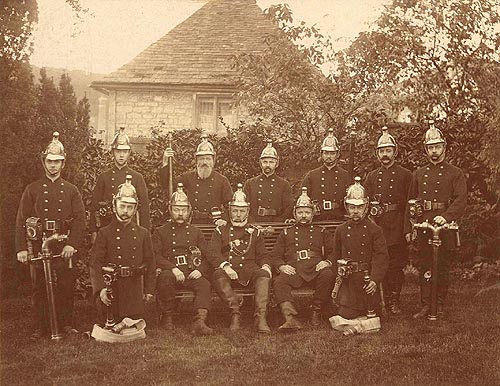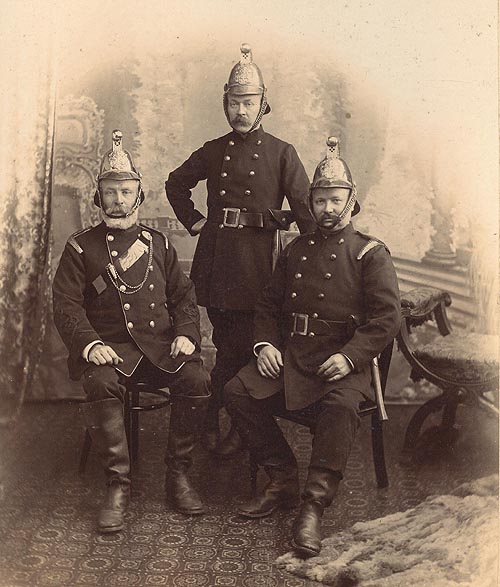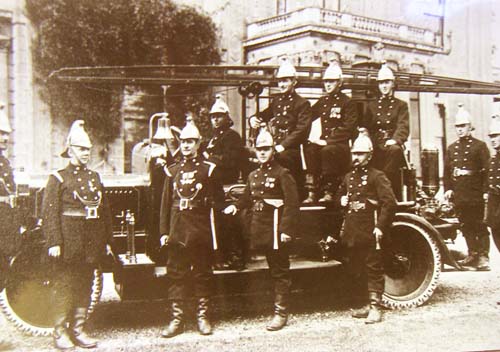Fire
Brigade , Bradford on Avon



As for the equipment and daily
happenings of the brigade, it must be remembered that Bradford was a small
town arid consequently its financial ambitions were scaled accordingly.
For instance, it is extremely difficult to imagine what sophisticated
equipment was involved in the 'purchase in 1913, for the comparatively
low cost of £16.18s. 0d. (£16.90) of a 'Water Motor and Gong"
- no clue is given as to what it was or how or where it could be used.
In 1914 more hose was purchased and it was also decided to provide the
firemen with new uniforms at £15 each. When Charles Earle was Chief
Officer, in 1915, the Council considered the advantages of purchasing
a motor pump as against the use of a motor tractor to tow a pump, but
it was considered that the tractor would be impracticable in the locality,
Considering the Bradford area and its steep hills, it raises the question
as to just what was meant by the term tractor when considering the versatility
of that type of power unit.
The death was announced in February 1923 of Chief Officer G.C. Earle and
he was succeeded by Captain J. Stafford at which time it is learnt that
the fire station was in St. Margaret's Street. In 1935 there is a short
report to the effect that Deputy Chief Officer H.E. Long was retiring
on grounds of ill-health after serving for 35 years.
It becomes quite clear that the fire brigade in Bradford developed quite
slowly compared with many other brigades in the locality. For instance
it was in 1923 that a fire siren was provided and sited at the rubber
works whilst in the same year, a new hosecart was purchased a hand-drawn
affair which is strange when it is considered that at this time new appliances
were capable of being either self-propelled or, at the very least towed
by a vehicle of sorts. It is true however that the Council did make arrangements
for the hiring of a motor lorry to tow the fire engine, although no mention
was made as to just what sort of engine was actually available at this
time. It might be assumed, however, that it was a motor-powered, trailer
pump which would have been quite a different sort of appliance from that
being envisaged in the discussions held in 1915 about a new motor pump.
By mid 1925 though, serious thought was given to the matter of a motor
pump and eventually it seems that the decision was taken to purchase a
40 h. p. 250/300 g.p.m. "Martin" fire engine and in the details
of the mutual assistance scheme arranged between a number of towns in
the county (see Chippenham for details) it was quite clear that Bradford
on Avon did indeed have its own motor-driven pump. Whether coincidental
or not is not at all clear but in early 1939, i.e. soon after the coming
into force of the Fire Brigades Act 1938, it is reported that Bradford-on-Avon
is to have a new 350 g.p.m. motor pump, a 350 g.p.m. trailer pump and
a Tender complete with extension ladders as well as new uniforms for the
men (presumably the first new issue since that of 1914). This could have
been the result of co-operation between the Urban and Rural Councils on
the lines of their earlier agreement for joint provision of a fire brigade
to cover the whole of the Rural District,
Just prior to the nationalisation of fire services in 1942 long service
medals were presented to Chief Officer W. Rossiter (it might be surmised
that he was a descendent of Superintendent E.J. Rossiter in command in
1885), Deputy Chief Officer H.W. Brown, Engineer R. Ewence and Firemen
J. Drew and H.S. Smith.
As usual there is no available record of happenings during the National
Fire Service period until a press report, of 16th August, 1947 regarding
a fire at the Granby Hotel, Westwood, went into some detail because of
public concern about the incident. It was alleged that a call to the brigade
was made from the hotel at 1930 hours but as far as the fire service was
concerned the call was not received until 1952 hours. The first attendance
was reinforced by appliances from Bristol, Bath, Trowbridge, Melksham
and seven other stations but despite all this the fire engulfed the entire
three storey building and it was destroyed in three hours. The fire fighting
was hampered by a water shortage and sightseers got in the way of appliances
setting up a relay from the canal some way .away in Bradford itself. There
was 'apparently also a lot of pilfering of guests' property and this happened,
it was reported, because the guests had thrown their property out of bedroom
windows before leaving themselves and, incidentally, leaving the windows
wide open so assisting the fire to spread.